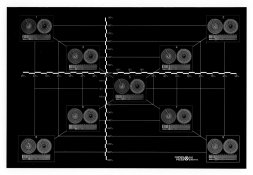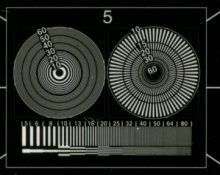Marco Buonocore
Member
Interesting thread here. I've read in the past that enlarger lenses used wide open is optimal. Obviously this assumes glass carrier, aligned enlarger, etc... I've never found it to be true. This is with more than a few 6-element lenses, and a few APOs. I consistently found that the sharpest prints were made 1 or 2 stops down. Without exception, the worst results came from a lens full stopped down - I'd change bulbs or switch to a longer lens before using my lenses at f16 or f22.
I make my judgements using test negatives for the appropriate format. This one is for 35mm:

Close up of detail:

If you make prints with something like this, you'll see right away where your lens fails or shines, it's as clear as day.
I find wide open, the corners suffer. That's not to say I won't use my lens wide open, that's foolish. Like Bob says, for a mural print, or a lith print, I'll often use it wide open. The extra light is absolutely worth the trade off. I had a few mural rolls of Fotokemika Emaks paper - man was that stuff slow! One of the slowest papers I remember using. So am I going to stop down two stops if I've already got a 6 minute exposure time? Probably not.
Going back to the test negative above. In real world applications, an actual photograph, the differences in aperture (with the exception of fully closed down) are pretty slight. I'll try and stick to the sweet spot, but will use whatever aperture gives a useful exposure time.
To the OP, I wonder about the quality of the actual negative in question, not the lenses and alignment? I've got plenty of negatives that absolutely fail when making a 30-40 X enlargement. I shoot handheld on Tri-X, sometimes wide open on my Rolleiflex. They're great for a 10 X enlargement, really beautiful, but you can't make a mural out of every one. I think it takes a special negative to make a tack sharp 30-40 X enlargement. I've had people want murals printed from obviously out of focus 35mm negs; I remember telling them I could make a decent 5x7 and that's it, and suggested re-shooting. If you're really fussy, I would say using a tripod is probably a must. I hate tripods.
Good luck!
I make my judgements using test negatives for the appropriate format. This one is for 35mm:

Close up of detail:

If you make prints with something like this, you'll see right away where your lens fails or shines, it's as clear as day.
I find wide open, the corners suffer. That's not to say I won't use my lens wide open, that's foolish. Like Bob says, for a mural print, or a lith print, I'll often use it wide open. The extra light is absolutely worth the trade off. I had a few mural rolls of Fotokemika Emaks paper - man was that stuff slow! One of the slowest papers I remember using. So am I going to stop down two stops if I've already got a 6 minute exposure time? Probably not.
Going back to the test negative above. In real world applications, an actual photograph, the differences in aperture (with the exception of fully closed down) are pretty slight. I'll try and stick to the sweet spot, but will use whatever aperture gives a useful exposure time.
To the OP, I wonder about the quality of the actual negative in question, not the lenses and alignment? I've got plenty of negatives that absolutely fail when making a 30-40 X enlargement. I shoot handheld on Tri-X, sometimes wide open on my Rolleiflex. They're great for a 10 X enlargement, really beautiful, but you can't make a mural out of every one. I think it takes a special negative to make a tack sharp 30-40 X enlargement. I've had people want murals printed from obviously out of focus 35mm negs; I remember telling them I could make a decent 5x7 and that's it, and suggested re-shooting. If you're really fussy, I would say using a tripod is probably a must. I hate tripods.
Good luck!



 about how the apo componon beats the componon-s ... or not...
about how the apo componon beats the componon-s ... or not... 

